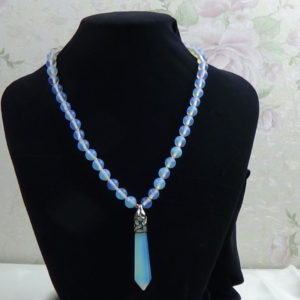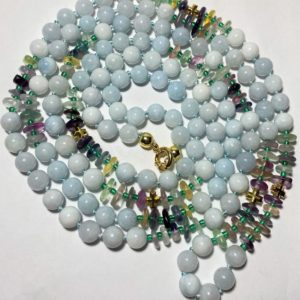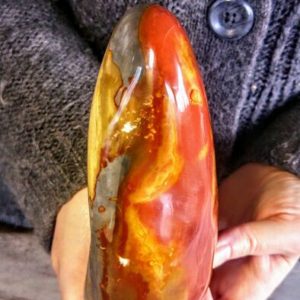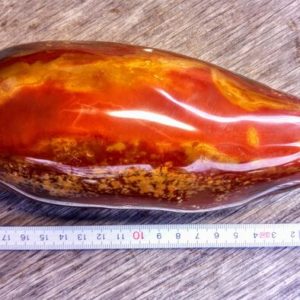Lapis Lazuli NECKLACES
297 £ Original price was: 297 £.277 £Current price is: 277 £.
Lapis lazuli is a highly sought-after gemstone known for its intense blue color and historical significance. High-quality lapis lazuli exhibits specific characteristics that distinguish it from lower-grade stones. Here’s what you need to know about top-quality lapis lazuli:
Characteristics of Top-Quality Lapis Lazuli
- Color: The most prized lapis lazuli is a deep, rich royal blue with minimal to no white calcite inclusions. It may contain small flecks of golden pyrite, which add to its allure but should be evenly distributed.
- Texture: Top-quality lapis lazuli has a smooth, uniform texture. It should feel solid and dense when held.
- Inclusions: A small amount of pyrite is desirable, giving the stone a subtle, star-like appearance. However, too much pyrite or calcite can lower the stone’s value.
- Polish: It should have a high polish and a glossy finish, enhancing its natural beauty and making the color appear more vibrant.
Sources
The finest lapis lazuli has historically come from the Sar-e-Sang mines in Afghanistan. Other notable sources include:
- Chile
- Russia
- Pakistan
- Italy
Uses
- Jewelry: Lapis lazuli is often used in high-end jewelry, including rings, necklaces, bracelets, and earrings. Its striking blue color makes it a favorite among designers.
- Carvings: Due to its relatively soft nature (Mohs hardness of 5-5.5), lapis lazuli is also carved into decorative objects, sculptures, and inlays.
- Healing and Metaphysical: In the metaphysical community, lapis lazuli is believed to promote wisdom, truth, and inner peace. It is often used in meditation and energy healing practices.
Care and Maintenance
- Cleaning: Clean lapis lazuli with a soft, damp cloth. Avoid using ultrasonic cleaners, harsh chemicals, or prolonged exposure to water, as these can damage the stone.
- Storage: Store lapis lazuli separately from harder gemstones to prevent scratches. A soft pouch or lined jewelry box is ideal.
- Handling: Due to its softness, handle lapis lazuli with care to avoid chipping or scratching.
Selecting High-Quality Lapis Lazuli
When purchasing lapis lazuli, consider the following:
- Color Consistency: Look for stones with consistent, deep blue color without large patches of white calcite.
- Pyrite Inclusions: Ensure any pyrite inclusions are small and evenly distributed.
- Surface Quality: Check for a high polish and minimal surface blemishes or fractures.
Conclusion
Lapis lazuli can be utilized in various ways depending on your interests and needs. Here are some detailed ideas for using lapis lazuli in jewelry, as collectible items, and for its metaphysical properties:
Using Lapis Lazuli in Jewelry
- Necklaces and Pendants: A lapis lazuli pendant or necklace can serve as a striking statement piece. The deep blue color pairs well with both silver and gold settings.
- Rings: Lapis lazuli rings are elegant and can range from bold statement pieces to more delicate designs. It’s essential to set the stone securely due to its relative softness.
- Bracelets: Beaded lapis lazuli bracelets or bangles can be a beautiful addition to your jewelry collection. They can be combined with other stones like turquoise or onyx for a colorful and unique look.
- Earrings: Lapis lazuli earrings, whether in the form of studs, dangles, or hoops, can add a pop of color to any outfit.
- Brooches and Pins: These can be adorned with intricate carvings or designs, adding a touch of vintage elegance.
Collectible Items
- Carvings and Sculptures: Lapis lazuli is often carved into intricate sculptures, animal figurines, or abstract art pieces. These collectibles are treasured for their craftsmanship and beauty.
- Cabochons and Loose Stones: Collecting loose lapis lazuli stones or cabochons can be a rewarding hobby. You can appreciate their natural beauty and use them in custom jewelry designs.
- Inlaid Objects: Lapis lazuli is often inlaid into decorative items such as boxes, mosaics, and furniture. These pieces can become treasured heirlooms.
- Historical Artifacts: Antique items or replicas that use lapis lazuli, such as ancient Egyptian jewelry or Renaissance art pieces, can be fascinating to collect and study.
Metaphysical Properties
- Meditation and Spiritual Growth: Lapis lazuli is known for its spiritual and healing properties. It is believed to enhance self-awareness, inner truth, and mental clarity. Meditating with lapis lazuli can help you connect with your inner self and achieve a deeper state of peace.
- Chakra Healing: Lapis lazuli is associated with the throat chakra (Vishuddha) and the third eye chakra (Ajna). Placing the stone on these chakras during meditation can aid in communication and intuition.
- Dream Work: Keeping lapis lazuli under your pillow or on your nightstand is believed to enhance dream recall and provide insight into your subconscious mind.
- Emotional Healing: Wearing or carrying lapis lazuli can help relieve stress, reduce anger, and promote a sense of calm and tranquility.
- Energy Grids: Use lapis lazuli in crystal grids to amplify its healing properties. Combine it with other stones like amethyst, clear quartz, or sodalite to create powerful energy fields.
Tips for Choosing Lapis Lazuli
- Evaluate Color: Look for a deep, rich blue color with minimal white calcite. Small, evenly distributed pyrite flecks can enhance the stone’s beauty.
- Check for Authenticity: Be cautious of synthetic or dyed lapis lazuli. Authentic lapis lazuli will have a consistent blue color and natural inclusions.
- Quality of Polish: High-quality lapis lazuli should have a smooth, glossy finish without visible cracks or dull spots.
Conclusion
Whether you’re drawn to lapis lazuli for its stunning appearance, historical significance, or metaphysical properties, this versatile gemstone offers a wide range of possibilities. You can wear it as jewelry, collect it as a precious item, or use it to enhance your spiritual practices. By understanding and appreciating its unique qualities, you can make the most of this remarkable stone
Top-quality lapis lazuli is a magnificent and valuable gemstone that adds elegance and a touch of history to any collection. Its rich blue color and unique inclusions make it a standout choice for jewelry and decorative pieces.
Lapis lazuli is a highly sought-after gemstone known for its intense blue color and historical significance. High-quality lapis lazuli exhibits specific characteristics that distinguish it from lower-grade stones. Here’s what you need to know about top-quality lapis lazuli:
Characteristics of Top-Quality Lapis Lazuli
- Color: The most prized lapis lazuli is a deep, rich royal blue with minimal to no white calcite inclusions. It may contain small flecks of golden pyrite, which add to its allure but should be evenly distributed.
- Texture: Top-quality lapis lazuli has a smooth, uniform texture. It should feel solid and dense when held.
- Inclusions: A small amount of pyrite is desirable, giving the stone a subtle, star-like appearance. However, too much pyrite or calcite can lower the stone’s value.
- Polish: It should have a high polish and a glossy finish, enhancing its natural beauty and making the color appear more vibrant.
Sources
The finest lapis lazuli has historically come from the Sar-e-Sang mines in Afghanistan. Other notable sources include:
- Chile
- Russia
- Pakistan
- Italy
Uses
- Jewelry: Lapis lazuli is often used in high-end jewelry, including rings, necklaces, bracelets, and earrings. Its striking blue color makes it a favorite among designers.
- Carvings: Due to its relatively soft nature (Mohs hardness of 5-5.5), lapis lazuli is also carved into decorative objects, sculptures, and inlays.
- Healing and Metaphysical: In the metaphysical community, lapis lazuli is believed to promote wisdom, truth, and inner peace. It is often used in meditation and energy healing practices.
Care and Maintenance
- Cleaning: Clean lapis lazuli with a soft, damp cloth. Avoid using ultrasonic cleaners, harsh chemicals, or prolonged exposure to water, as these can damage the stone.
- Storage: Store lapis lazuli separately from harder gemstones to prevent scratches. A soft pouch or lined jewelry box is ideal.
- Handling: Due to its softness, handle lapis lazuli with care to avoid chipping or scratching.
Selecting High-Quality Lapis Lazuli
When purchasing lapis lazuli, consider the following:
- Color Consistency: Look for stones with consistent, deep blue color without large patches of white calcite.
- Pyrite Inclusions: Ensure any pyrite inclusions are small and evenly distributed.
- Surface Quality: Check for a high polish and minimal surface blemishes or fractures.
Conclusion
Top-quality lapis lazuli is a magnificent and valuable gemstone that adds elegance and a touch of history to any collection. Its rich blue color and unique inclusions make it a standout choice for jewelry and decorative pieces.
Lapis lazuli can be utilized in various ways depending on your interests and needs. Here are some detailed ideas for using lapis lazuli in jewelry, as collectible items, and for its metaphysical properties:
Using Lapis Lazuli in Jewelry
- Necklaces and Pendants: A lapis lazuli pendant or necklace can serve as a striking statement piece. The deep blue color pairs well with both silver and gold settings.
- Rings: Lapis lazuli rings are elegant and can range from bold statement pieces to more delicate designs. It’s essential to set the stone securely due to its relative softness.
- Bracelets: Beaded lapis lazuli bracelets or bangles can be a beautiful addition to your jewelry collection. They can be combined with other stones like turquoise or onyx for a colorful and unique look.
- Earrings: Lapis lazuli earrings, whether in the form of studs, dangles, or hoops, can add a pop of color to any outfit.
- Brooches and Pins: These can be adorned with intricate carvings or designs, adding a touch of vintage elegance.
Collectible Items
- Carvings and Sculptures: Lapis lazuli is often carved into intricate sculptures, animal figurines, or abstract art pieces. These collectibles are treasured for their craftsmanship and beauty.
- Cabochons and Loose Stones: Collecting loose lapis lazuli stones or cabochons can be a rewarding hobby. You can appreciate their natural beauty and use them in custom jewelry designs.
- Inlaid Objects: Lapis lazuli is often inlaid into decorative items such as boxes, mosaics, and furniture. These pieces can become treasured heirlooms.
- Historical Artifacts: Antique items or replicas that use lapis lazuli, such as ancient Egyptian jewelry or Renaissance art pieces, can be fascinating to collect and study.
Metaphysical Properties
- Meditation and Spiritual Growth: Lapis lazuli is known for its spiritual and healing properties. It is believed to enhance self-awareness, inner truth, and mental clarity. Meditating with lapis lazuli can help you connect with your inner self and achieve a deeper state of peace.
- Chakra Healing: Lapis lazuli is associated with the throat chakra (Vishuddha) and the third eye chakra (Ajna). Placing the stone on these chakras during meditation can aid in communication and intuition.
- Dream Work: Keeping lapis lazuli under your pillow or on your nightstand is believed to enhance dream recall and provide insight into your subconscious mind.
- Emotional Healing: Wearing or carrying lapis lazuli can help relieve stress, reduce anger, and promote a sense of calm and tranquility.
- Energy Grids: Use lapis lazuli in crystal grids to amplify its healing properties. Combine it with other stones like amethyst, clear quartz, or sodalite to create powerful energy fields.
Tips for Choosing Lapis Lazuli
- Evaluate Color: Look for a deep, rich blue color with minimal white calcite. Small, evenly distributed pyrite flecks can enhance the stone’s beauty.
- Check for Authenticity: Be cautious of synthetic or dyed lapis lazuli. Authentic lapis lazuli will have a consistent blue color and natural inclusions.
- Quality of Polish: High-quality lapis lazuli should have a smooth, glossy finish without visible cracks or dull spots.
Conclusion
Whether you’re drawn to lapis lazuli for its stunning appearance, historical significance, or metaphysical properties, this versatile gemstone offers a wide range of possibilities. You can wear it as jewelry, collect it as a precious item, or use it to enhance your spiritual practices. By understanding and appreciating its unique qualities, you can make the most of this remarkable stone
Do you have any specific plans for using lapis lazuli, such as in jewelry or as a collectible item? Or are you interested in learning more about its metaphysical properties?
Related products
Spiritual Connection
angels
Uncategorized
angels

















